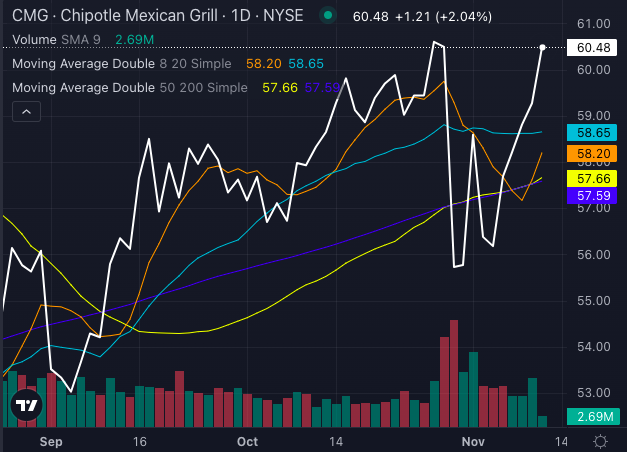Amidst the tumultuous seas of the stock market, Nvidia Corporation (NVDA) has emerged as a shining beacon in the chip industry, riding the wave of the artificial intelligence (AI) revolution to remarkable heights. With tech titans relying on its specialized chips to power their AI models, Nvidia has solidified its supremacy within the sector.
The chip giant’s unprecedented surge over the past year, fueled by an insatiable demand for its AI-centric chips, has captured the attention of the entire market. This meteoric rise has elevated it to the esteemed position of the world’s third most valuable company, trailing only behind industry behemoths such as Apple (AAPL) and Microsoft (MSFT).
As retail investors clamored to partake in Nvidia’s extraordinary ascent, Goldman Sachs (GS) strategist Scott Rubner dubbed NVDA the “most important stock” of the year. Additionally, Philippe Laffont’s Coatue Management recently unveiled a substantial increase in its Nvidia investment, signaling a resounding vote of confidence in the chip giant’s future. But with Nvidia facing volatility and skepticism post-earnings, is it prudent to follow the lead of these billionaire investors? Let’s delve deeper to unravel the story.
The Nvidia Narrative
Boasting a colossal market capitalization of approximately $2.89 trillion, Nvidia Corporation (NVDA) stands as the vanguard of GPU technology, transitioning from a PC graphics specialist to a pioneer in AI-powered solutions. Its GPUs, equipped with parallel processing and numerous cores, play a pivotal role in HPC, gaming, and VR. The company leads the charge in burgeoning sectors like robotics and self-driving cars, outshining rivals Intel (INTC) and Advanced Micro Devices (AMD) in the data center, professional visualization, and gaming realms.
Nvidia investors have embarked on a rollercoaster journey over the past two years, with the AI boom propelling the stock to phenomenal gains exceeding 1,000% from its October 2002 lows. In June, Nvidia briefly claimed the mantle of the world’s most valuable public company; however, the subsequent trajectory has been rife with volatility. Despite a pullback of nearly 15.7% from its June peaks, the chip juggernaut still boasts impressive gains of 144.6% over the past year and 141% year-to-date, outperforming the broader S&P 500 Index’s double-digit returns during both periods.
While NVDA shares trade at a lofty 50.10 times forward earnings, indicative of a steep valuation, the stock’s price/earnings to growth (PEG) ratio conveys a different narrative. At 1.33x, Nvidia’s PEG sits below the sector median of 1.89x and its historical average of 2.09x, suggesting that the stock remains reasonably priced in light of its robust growth prospects.
In addition to stellar stock performance, Nvidia has been rewarding shareholders through dividends and substantial share repurchases. The company announced a quarterly dividend of $0.01 per share in its recent earnings release, scheduled to be distributed to shareholders on October 3. With a forward annualized dividend of $0.04 per share, yielding 0.03%, Nvidia returned a noteworthy $15.4 billion to shareholders in the first half of fiscal 2025 through buybacks and dividends. Armed with $7.5 billion available for repurchases and a colossal $50 billion freshly approved, the company remains steadfast in its commitment to rewarding investors.
Nvidia’s Post-Earnings Performance
Following a stellar Q1 earnings report that exceeded expectations, Nvidia’s highly-anticipated fiscal Q2 earnings once again surpassed Wall Street projections both on the top and bottom lines. Notably, Nvidia’s total revenue of $30 billion surpassed estimates of $28.8 billion and surged by a remarkable 122% year-over-year.
The company’s data center revenue, inclusive of its AI processors, skyrocketed by 154% annually to reach $26.3 billion, constituting a substantial 88% of total sales. On an adjusted basis, Nvidia’s earnings of $0.68 per share recorded a notable 151.9% annual increase, surpassing expectations by a significant margin.
Despite delivering impressive Q2 results, Nvidia’s stock experienced a 6.4% decline post-earnings, signaling a substantial beat already factored into the stock price. With a forecast of 80% revenue growth in Q3, lower than anticipated, concerns arose over potential delays in the release of the next-gen Blackwell processors, dampening investor sentiment towards NVDA shares.
During the Q2 earnings call, management hinted at a potential delay in the production ramp-up of the next-gen Blackwell chip platform, potentially pushing its 2024 release to 2025. While rumors of a delay had circulated pre-earnings, heightened expectations caused investors to hone in on this setback rather than the company’s otherwise robust performance.
As we look ahead to fiscal 2025 Q3,
The Rise of Nvidia: Coatue Management Makes a Strategic Gamble
Coatue Management: A Bold Bet on Nvidia
Philippe Laffont’s Coatue Management executed a daring move by significantly increasing its stake in Nvidia during the last quarter. While other hedge funds were scaling back their positions, Coatue boosted its holdings by a staggering 893%, catapulting from 1.39 million shares to a jaw-dropping 13.75 million. This bold step, now valued at approximately $1.7 billion, showcases Coatue’s unwavering confidence in Nvidia’s supremacy in AI and high-performance computing.
Despite prior reductions in Nvidia holdings, this massive increase positions Nvidia as a pivotal asset in Coatue’s portfolio, comprising around 6.6% of its total holdings—up from 4.9% in the previous quarter. As Nvidia continues to exhibit robust growth in response to soaring AI demand, Coatue’s significant investment indicates optimism for continued upside in the future.
Analysts’ Projections for Nvidia Stock
Following Coatue’s move, Wall Street analysts express unwavering confidence in Nvidia’s future. Goldman Sachs’ Toshiya Hari maintains a “Conviction Buy” rating with a $135 price target, emphasizing Nvidia’s data center revenue potential and the outlook for increased Hopper sales. JP Morgan’s Harlan Sur echoes a positive sentiment, emphasizing Nvidia’s product launch strategy to outshine competitors and increasing his price target to $155 per share.
Cantor Fitzgerald’s C.J. Muse remains bullish, affirming a $175 price target and an “Overweight” rating for NVDA. Muse dismisses concerns about product delays, viewing the current dip in stock price as a prime buying opportunity. Overall, Wall Street sentiment remains highly optimistic, with a consensus “Strong Buy” rating from 39 analysts, reinforcing the positive outlook for Nvidia stock.
According to the analysts, Nvidia’s mean price target stands at $142.60, indicating a potential upside of 19.5% from current levels. The highest target price of $200 reflects the possibility of a significant 67.5% rally from the current price.


